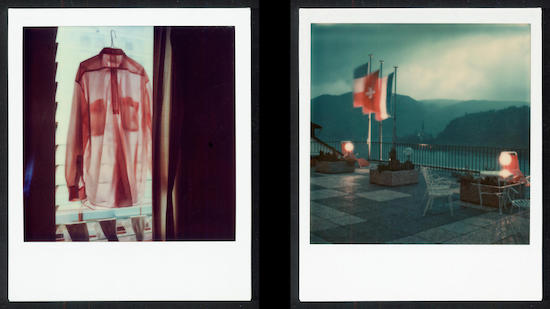“The more honest you are, the better,” Robby Müller once said, in a 2007 interview with Bart van Broekhoven. “I was always very faithful to the story.” Even in an exhibition of stills, this profession of fidelity to the demands of a narrative somehow still holds. In every isolated shot, here in Rotterdam’s Slash Gallery, lies a question, a movement, a before and an after. In their motionlessness, their remains nonetheless a sense of keeping faith with time, of being true to the possibility of movement. In that same 2007 interview, Müller referred to a particular scene in Fellini’s 81/2. Speaking of the introduction of Claudia Cardinale’s character, he speaks of her being “carried by light”. I am reminded of that sentiment as I gaze at these images of hotel rooms, flowers, cityscapes. They are carried – in the sense both of being supported, but also transported – by the light that they capture. Everything floats.
Relaxing on his hotel bed in Austin, Texas during a break in the filming of Honeysuckle Rose with Jerry Schatzberg, Müller takes out his Polaroid camera and takes a snap. You can see he end of the bed, a fragment of anonymous hotel furniture, lampshade, TV screen, the window of the room and the daylit skyline beyond. He waits, not moving. Click. Another snap. More waiting. Click. Placed together, the sequence of three images becomes a story whose protagonist is the daylight itself as it snakes through the room, redistributing the visibility of its contents.
Many of the pictures on display here are in these kind of series: diptychs, triptychs and longer, more elaborate sequences of stills. A set of five Eiffel Towers at dusk taken in 1985. Six shots of a set of curtains billowing in the breeze inside New York’s Hotel Mayflower in 1986. It’s more than just a concession to classical aesthetics and the quasi-sacral procession of Renaissance iconography. Closer to an investigation of the minimal conditions of cinema, the least possible ingredients required to animate a story.
The Dutch-born cinematographer, renowned for his collaborations with Wim Wenders (Alice in the City, Paris, Texas), Jim Jarmusch (Down By Law, Mystery Train) and Lars Von Trier (Breaking the Waves, Dancer in the Dark), Müller’s is an eye that adds drama to the most mundane of things. In the still Kensington Motel (1985), striped shadows upon a kettle give it the aspect of a weapon – or a body – in a classic Hollywood noir.
But most of all, what one takes away from this exhibition is a sense of the photographer’s fascination with light itself, its multiple reflections and refractions. He catches the gleam of the surface; not the depth of things.
Looking at Müller’s images of flowers or cityscapes one witnesses an ability to see real things as abstract arrangements of pigment and tone. A rose is a rose is a rose is a particular agglomeration of red and pink and opacity and translucence. It is not a symbol or love or passion or mortality or anything at all. It just is.
Born in Curaçao in the Dutch Antilles, Müller moved to Amsterdam with his family at 13 and went on to study at the Netherlands Film Academy, there, from 1962 to ‘64. But it was meeting Wim Wenders and working on the director’s first short, Alabama (2000 Light Years) in 1969 that proved decisive. The pair made around a dozen features together, from 1970 to 1995 and their reputations rose in tandem, leading to later collaborations with such celebrated directors as Peter Bogdanovich, Sally Potter, Barbet Schroeder, William Friedkin, and John Schlesinger. He became renowned as a master of that rarest of contemporary cinematic beasts: the mid-shot. But he was equally adept at adapting his style to different media and different technologies. His turn of the century collaborations with Von Trier and Michael Winterbottom practically defined the language of a new kind of digital film-making. The Polaroid photos on display at Slash Gallery are no less attentive to the specificity of the apparatus.
We see Müller himself only once in these images: in a shot from 1998 taken while shooting Mystery Trainin Memphis, Tennessee. We see the back end of a powder blue estate car in a motel carpark. In its rear window, we catch the photographer in reflection, looking down from a balcony in shorts and straggly blond hair, a cigarette cocked at the side of his mouth. He holds the camera by his side, propped against the bannister at chest height. Instead of looking through the viewfinder, he stares directly at the viewer in the dead centre of the shot. His gaze peering blankly down, inscrutable. Somehow, he looks like he could just stand there with his camera like that all day. Maybe he did. Waiting for just the right play of light and shadow to catch his subject. Waiting, he evanesces, becoming somehow insubstantial, a figure of pure light.


